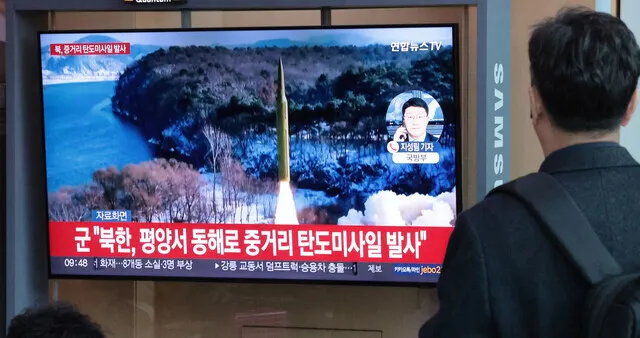hankyoreh
Links to other country sites 다른 나라 사이트 링크
Signs point to solid-fuel, hypersonic ballistic missile in latest launch by N. Korea

South Korea’s Joint Chiefs of Staff announced Tuesday that it had detected a projectile believed to be a medium-range ballistic missile launched toward the East Sea from the Pyongyang area at 6:53 that morning.
It also said the North Korean projectile “flew for around 600 kilometers before landing in the East Sea.”
Japan’s NHK network quoted the Japan Ministry of Defense as saying the North Korean missile flew a distance of over 650 km and reached a maximum altitude of 100 km, adding that it was believed to have landed outside of Japan’s exclusive economic zone.
South Korean military authorities speculated that the North may have conducted a test launch of a hypersonic missile using solid fuel.
In a regular briefing, Joint Chiefs spokesperson Lee Sung-jun said the projectile in question “bears some similarities to and some differences from the hypersonic missile launched [by North Korea] in January.”
“We are considering it to be related to the ground testing of solid fuel reported by North Korea in March,” he explained.
In January, North Korea conducted a test launch of a solid propellant-based intermediate-range ballistic missile with a hypersonic maneuverable piloted warhead. On March 20, it conducted ground testing of a multistage solid-fueled engine to be used with its new model of intermediate-range hypersonic missile.
Due to their irregular flight patterns, hypersonic missiles are difficult to track and intercept. The use of solid propellant allows for faster and more discreet launching, which further complicates early detection and interception.
The same day, South Korea joined the US and Japan in conducting air exercises with fighter aircraft taking part from all three sides. Conducted where the South Korean and Japanese air defense identification zones (ADIZs) intersect southeast of Jeju, the exercises also included the deployment of US B-52H strategic bombers.
The South Korean Ministry of National Defense explained that the exercises were held to improve deterrence and response capabilities against the growing North Korean nuclear and missile threats.
Meanwhile, the South Korean government announced the same day that it had designated two Russian ships involved in the transport of military goods between North Korea and Russia as being subject to independent North Korea sanctions as of Wednesday, along with two Russian institutions and two individuals involved in the dispatching of overseas North Korean workers.
This is the first time the South Korean government has announced independent sanctions specifically targeting Russian nationals and institutions. Analysts interpreted it as a response to Russia’s actions on March 28 in casting a vote opposing a term extension for the UN Sanctions Committee on North Korea’s panel of experts.
By Kwon Hyuk-chul, staff reporter
Please direct questions or comments to [english@hani.co.kr]

Editorial・opinion
![[Column] There’s no solving the feud between Japan and China [Column] There’s no solving the feud between Japan and China](https://flexible.img.hani.co.kr/flexible/normal/500/300/imgdb/original/2025/1121/271763714973635.jpg) [Column] There’s no solving the feud between Japan and China
[Column] There’s no solving the feud between Japan and China![[Correspondent’s column] Goodbye MAGA, hello affordability? [Correspondent’s column] Goodbye MAGA, hello affordability?](https://flexible.img.hani.co.kr/flexible/normal/500/300/imgdb/original/2025/1121/7417637152471688.jpg) [Correspondent’s column] Goodbye MAGA, hello affordability?
[Correspondent’s column] Goodbye MAGA, hello affordability?- [Editorial] PPP lawmakers get slap on the wrist for violent violation of legislative procedure
- [Editorial] Long-awaited victory in Lone Star case should be a lesson
- [Column] Korea: The country without a plan B
- [Editorial] China, Japan must deescalate before tensions boil over into military actions
- [Column] What the media’s Mamdani-bashing missed
- [Column] Another Eulsa Year, another blow to Korea’s sovereignty
- [Editorial] South Korea is not a US outpost
- [Column] Trump’s kingdom, Xi’s empire
Most viewed articles
- 1[Column] There’s no solving the feud between Japan and China
- 2Could China go as far as restricting exports of rare earths to Japan?
- 3[Editorial] Need to get to the bottom of Chinese fisherman’s death
- 4President Moon cancels plans for biased state-authored history textbooks
- 5[Correspondent’s column] Goodbye MAGA, hello affordability?
- 6Former S. Korea President Roh commits suicide
- 7Park administration’s distorted history textbooks made public
- 8Lee vows Korea’s support to achieve ‘Miracle on the Nile’ in Egypt
- 9A blatant attempt to meddle in politics lays bare Korea’s status as a ‘prosecutor state’
- 10Following the money: Investigators seek to verify if Unification Church cash reached Yoon